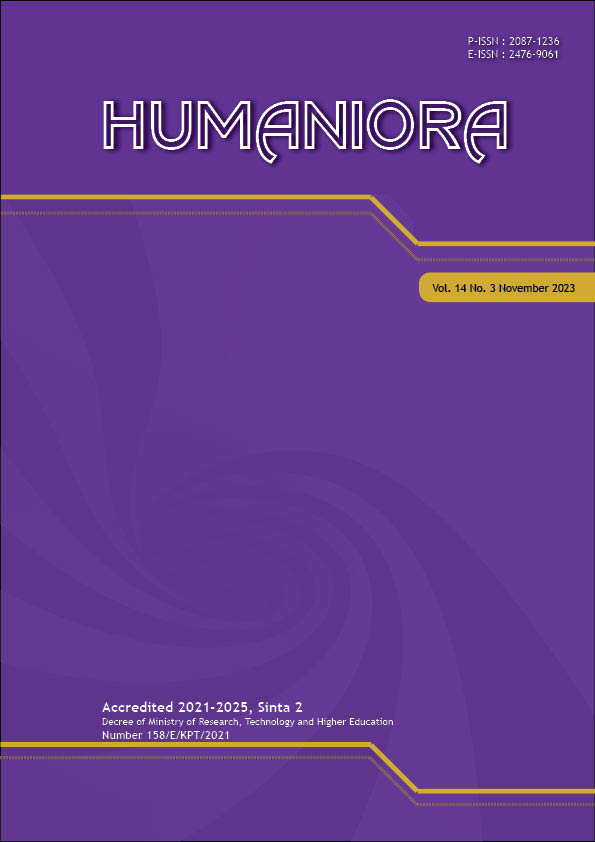The Power of Narration in Online Media to Support the Sustainability of Maos Batik
DOI:
https://doi.org/10.21512/humaniora.v14i3.7775Keywords:
narrative power, online news media, Maos batik, Diponegoro War codesAbstract
The research showed that historical events could create a narrative on batik motifs. The chronicle of the Javanese War had always been a part of the origins of Banyumasan Batik, including Maos Batik. The narrative about the Diponegoro War code on Maos Batik was a success factor in increasing the uniqueness of the Maos Batik. Although the truth was uncertain, this narrative was published and popularized through trusted online news media. The research used narrative analysis with a qualitative descriptive approach. Narrative data were collected through reliable sources, narrative analysis from Propp, and the semiotics of the Barthes signification system to reveal the myths and ideologies contained in the Maos Batik motif. Online questionnaire data was from 108 respondents to determine the respondent interest level after knowing the Batik motif's narrative as the code for the Diponegoro War. The research reveals that the narrative of the Maos Batik motif as a code for the Diponegoro War cannot be clarified the truth of its history. However, the socialization carried out by the company owners through the popularity of the leading online news media has made this narrative considered historical truth. Strengthened by the myths contained in the Maos Batik motif, it can function to naturalize history. If this is not considered a historical fact, then the narrative can be accepted as a marketing strategy. The dissemination of the narrative in Maos Batik through trusted online news media can enhance the uniqueness of Maos Batik, which becomes a differentiation from other regions. This attracts consumers to buy and supports sustainability of Maos Batik.Â
Plum Analytics
References
Anastasya, A., Misjedi, N. B, Gunawan, M. J., Leo, M., & Tunjungsari, H. K. (2021). The impact of storytelling marketing on brand equity and purchase decisions on Shopee during pandemic COVID-19. Proceedings of the 3rd Tarumanagara International Conference on the Applications of Social Sciences and Humanities (TICASH 2021). pp 2022-2026. https://doi.org/10.2991/assehr.k.220404.332.
Apriliyanto, G. (2019). Inovasi batik Banyumasan (Kajian perkembangan motif). Dimensi, 5(2), 133-154. https://doi.org/10.25105/dim.v15i2.5641.
Asa, K. (2006). Batik Pekalongan dalam lintasan sejarah. Pekalongan: Paguyuban Pecinta Batik Pekalongan.
Ayasofia, A. A., & Santoso, R. E. (2021). The development of Maos handwriting batik with Diponegoro War stories motif for dress. ARTY: Jurnal Seni Rupa, 10(1), 1-10.
Azizah, P., & Sembada, G. G. (2016). Brand identity Batik Maos Rajasamas sebagai salah satu potensi daerah Cilacap. Retrieved from https://openlibrarypublications.telkomuniversity.ac.id/index.php/artdesign/article/view/4132.
Barthes, R. (1972). Mytologies. Selected and translated from the French by Annete Lavers. New York: Noonday Press.
Biesenbach, R. (2018). Unleash the power of storytelling: Win hearts, change minds, get results. Illinois: Eastlawn Media.
Budiwaty, S., Maknun, T., Duli, A., & Muhammad, H. (2019). The myth of SUN purple sweet potato baby cereal advertisement in television (A semiotic study). International Journal of Science and Research (IJSR), 8(10), 1599-1602. http://dx.doi.org/10.21275/ART20202164.
Carey, P. (2019). Kuasa ramalan: Pangeran Diponegoro dan akhir tatanan lama di Jawa, 1785-1855 (Jilid 1). Jakarta: Gramedia.
Darajat, D. M., & Badruzzaman, M. (2020). Analisis fungsi narasi model Vladimir Propp dalam film “Surat dari Prahaâ€. Journal of Strategic Communication, 10(2), 40-57. https://doi.org/10.35814/coverage.v10i2.1382.
Dorno, J. (2014). Bentuk dan makna simbolik ornamen ukir pada interior masjid Gedhe Yogyakarta. Undergraduate Thesis. Retrieved from https://eprints.uny.ac.id/17241/1/Jeksi%20Dorno%2010207244022.pdf.
Huang, L. C., Gao, M., & Hsu, P. F. (2019). A study on the effect of storytelling marketing on brand image, perceived quality, and purchase intention in ecotourism. Ekoloji, 28(107), 283-287.
Husaina, A., Haes, P. E., Pratiwi, N. I., & Juwita, P. R. (2018). Analisis film “Coco†dalam teori semiotika Roland Barthes. Dinamika Sosial, 2(2), 53-70. https://doi.org/10.38043/jids.v2i2.1706.
Isnaniah, S., & Tiya A. (2020). “Covid-19†meme in social media: Study of Roland Barthes semiology. Bahtera: Jurnal Pendidikan Bahasa dan Sastra, 19(2), 351-378. https://doi.org/10.21009/bahtera.192.010.
Li, Y. (2017). A semiotic theory of institutionalization. Academy of Management Review, 42(3), 520-547. https://doi.org/10.5465/amr.2014.0274.
Lukman, C. C., & Hartanti, M. (2022). The phenomenon of mimicry and collective memory in Dutch East Indies soldier batik motifs. Mozaik Humaniora, 22(1), 15-29. https://doi.org/10.20473/mozaik.v22i1.32665.
Mencarelli, R., Chaney, D., & Pulh, M. (2020). Consumers' brand heritage experience: Between acceptance and resistance. Journal of Marketing Management, 36(1-2), 30-50. https://doi.org/10.1080/0267257X.2019.1692057.
Merlo, O. E., Gillingwater, A. B., Richard, C., & Jia, J. (2022). Exploring the changing role of brand archetypes in customer-brand relationships: Why try to be a hero when your brand can be more? Business Horizons, 66(5), 615-629. https://doi.org/10.1016/j.bushor.2022.11.001.
Pecot, F., Valetteâ€Florence, P., & De Barnier, V. (2019). Brand heritage as a temporal perception: Conceptualization, measure and consequences. Journal of Marketing Management, 35(17â€18), 1624-1643. https://doi.org/10.1080/0267257X.2019.1667414.
Pfannes, C., Meyer, C., Orth, U., & Rose, G. (2021). Brand narratives: Content and consequences among heritage brands. Psychology & Marketing, 38(11), 1867-1880. https://doi.org/10.1002/mar.21543.
Pizzi, G., & Scarpi, D. (2019). The year of establishment effect on brand heritage and attitudes. Journal of Consumer Marketing, 36(6), 827-834. https://doi.org/10.1108/JCM-05-2018-2665.
Putra, R. S. P., & Sudrajat, S. H. (2021). Analisis cerita naratif Vladimir Propp pada “Cerita KKN Desa Penari†versi channel Youtube Nessie Judge. E-Proceeding of Management, 8(4), 3823-3842.
Ramanta, H., & Samsuri, S. (2020). The values of local wisdom of Minangkabau culture in a Baralek Gadang traditional wedding. Humaniora, 11(3), 193-201. https://doi.org/10.21512/humaniora.v11i3.6625.
Rinardi, H., & Indrahti, S. (2003). Penelitian arsip dan dokumen tentang Perang Diponegoro 1825-1830. Retrived from http://eprints.undip.ac.id/22032/.
Saraswati, H., Iriyanto, E., & Putri, H. Y. (2019). Semiotika batik Banyumasan sebagai bentuk identitas budaya lokal masyarakat Banyumas. Piwulang Jawi: Jurnal Pendidikan Bahasa Jawa, 7(1), 16-22. https://doi.org/10.15294/piwulang%20jawa.v7i1.31435.
Sari, N. A., Fahrurrozi, F., & Sumantri, S. (2019). Improving narrative writing skills through video media utilization in class V students of Malaka Jaya Elementary School 07 Morning. International Journal for Educational and Vocational Studies, 1(8), 898-903. https://doi.org/10.29103/ijevs.v1i8.2254.
Sholikhah, I. M., Purwaningsing, D. R., & Wardani, E. (2017). Makna simbolis motif batik Banyumas sebagai realisasi nilai kearifan lokal masyarakat. Prosiding Seminar Nasional LPPM Unsoed: Pengembangan Sumber Daya Perdesaan dan Kearifan Lokal Berkelanjutan VII, 17. Purwokerto, Indonesia. pp 1397-1404.
Trisari, A. (2021). Struktur naratif Vladimir Propp (Tinjauan konseptual). Jurnal Salaka: Jurnal Bahasa, Sastra, dan Budaya Indonesia, 3(1), 10-19. https://doi.org/10.33751/jsalaka.v3i1.3315
Tsymbalenko, Y. (2018). Myths in media communication. Językoznawstwo, 4(23), 115-133. http://dx.doi.org/10.16926/j.2017.13.09.
Veldhuisen, H. C. (1997). Fabric of enchantment: Batik from the north coast of Java. Los Angeles: Los Angeles County Museum of Art.
Widodo, W., Soekarba S. R., & Kusharjanto, B. (2021). Pemaknaan motif Truntum Batik Surakarta: Kajian semiotik Charles W. Morris. Sutasoma: Jurnal Sastra Jawa, 9(2), 197-210. https://doi.org/10.15294/sutasoma.v9i2.51542.
Wijayanto, C. S., & Iswari, F. (2021). Semiotics analysis of Roland Barthes' theory on Pocari Sweat's "Sweat For Dream" advertisement. Cultural Syndrome, 3(2), 100-108. https://doi.org/10.30998/cs.v3i2.804.
Downloads
Published
How to Cite
Issue
Section
License
Copyright (c) 2023 Monica Hartanti, Christine Claudia Lukman

This work is licensed under a Creative Commons Attribution-ShareAlike 4.0 International License.
Authors who publish with this journal agree to the following terms:
a. Authors retain copyright and grant the journal right of first publication with the work simultaneously licensed under a Creative Commons Attribution License - Share Alike that allows others to share the work with an acknowledgment of the work's authorship and initial publication in this journal.
b. Authors are able to enter into separate, additional contractual arrangements for the non-exclusive distribution of the journal's published version of the work (e.g., post it to an institutional repository or publish it in a book), with an acknowledgment of its initial publication in this journal.
c. Authors are permitted and encouraged to post their work online (e.g., in institutional repositories or on their website) prior to and during the submission process, as it can lead to productive exchanges, as well as earlier and greater citation of published work.
USER RIGHTS
All articles published Open Access will be immediately and permanently free for everyone to read and download. We are continuously working with our author communities to select the best choice of license options, currently being defined for this journal as follows: Creative Commons Attribution-Share Alike (CC BY-SA)
























